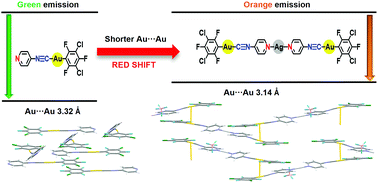4-Pyridylisocyanide gold(i) and gold(i)-plus-silver(i) luminescent and mechanochromic materials: the silver role†
Abstract
Crystallographic and DFT examination of the metalloligands [AuAr(CNPy-4)] (Ar = C6F5 (1), C6F3Cl2-3,5 (2)) and their silver complexes [Ag[AuAr(CNPy-4)]2](BF4) (3 and 4) support that the marked luminescence red-shifts observed on moving from 1 to 2, from 1,2 to 3,4, or upon grinding, are not caused by electronic differences (either by changing the aryls C6F5/C6F3Cl2, or by N coordination to silver), nor by non-existent Au⋯Ag interactions. They are always due to structural changes disturbing stronger π–π stackings in order to allow for shorter Au⋯Au interactions.



 Please wait while we load your content...
Please wait while we load your content...